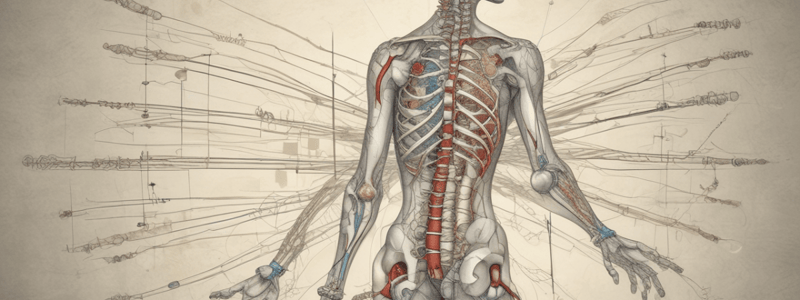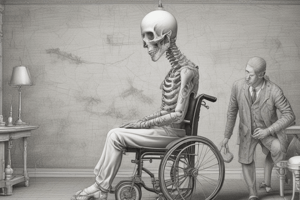Podcast
Questions and Answers
What are the two types of spinal cord injuries?
What are the two types of spinal cord injuries?
- Acute and Chronic
- Static and Dynamic
- Complete and Incomplete (correct)
- Primary and Secondary (correct)
Secondary injuries can worsen the initial injury.
Secondary injuries can worsen the initial injury.
True (A)
Which of the following is a risk factor for spinal cord injuries?
Which of the following is a risk factor for spinal cord injuries?
- Non-smokers
- Age over 60
- Regular exercise
- Young males (correct)
What level of injury can cause respiratory compromise?
What level of injury can cause respiratory compromise?
The loss of bladder control is a sign and symptom of __________.
The loss of bladder control is a sign and symptom of __________.
Match the following primary symptoms with their categories:
Match the following primary symptoms with their categories:
What is a common diagnostic method for spinal cord injuries?
What is a common diagnostic method for spinal cord injuries?
Spinal precautions are not necessary in the initial care of spinal cord injuries.
Spinal precautions are not necessary in the initial care of spinal cord injuries.
What is a complication of autonomic dysreflexia?
What is a complication of autonomic dysreflexia?
What should be done if a patient experiences autonomic dysreflexia?
What should be done if a patient experiences autonomic dysreflexia?
What are the two main types of spinal cord injuries?
What are the two main types of spinal cord injuries?
Young males are at a higher risk for spinal cord injuries.
Young males are at a higher risk for spinal cord injuries.
What is the significance of a cervical collar in patients with suspected spinal cord injuries?
What is the significance of a cervical collar in patients with suspected spinal cord injuries?
The initial care priority for spinal cord injuries is the _____ airway, breathing, and circulation.
The initial care priority for spinal cord injuries is the _____ airway, breathing, and circulation.
What medication is given to treat symptomatic bradycardia?
What medication is given to treat symptomatic bradycardia?
Unsteady gait is a potential sign of spinal cord injury.
Unsteady gait is a potential sign of spinal cord injury.
The Glasgow Coma Scale (GCS) is used for assessing _____ impairment.
The Glasgow Coma Scale (GCS) is used for assessing _____ impairment.
What is autonomic dysreflexia?
What is autonomic dysreflexia?
Which of the following is NOT a symptom of autonomic dysreflexia?
Which of the following is NOT a symptom of autonomic dysreflexia?
What should be done to treat a patient experiencing autonomic dysreflexia?
What should be done to treat a patient experiencing autonomic dysreflexia?
Flashcards are hidden until you start studying
Study Notes
Spinal Cord Injuries (SCIs)
- SCIs can be complete or incomplete
- Types of injuries: primary (related to the initial injury) and secondary (worsens the injury)
- Secondary injuries can be hemorrhage, ischemia, impaired tissue perfusion from shock, hypovolemia, or local edema
Risk Factors
- Young males
- Trauma (e.g., motor vehicle crashes, falls, acts of violence)
- Sports and recreational activities (e.g., diving in shallow water)
- Importance of prevention: educate patients to avoid risk-taking behaviors, wear protective gear/equipment, wear seatbelts, and avoid impaired driving
Level of Injury
- Level of injury depends on where the injury occurred
- Terms: -plegia (complete loss of motor function) vs -paresis (partial loss)
- Tetra- (quadri-) refers to all four limbs
- Para- refers to partial or incomplete paralysis
- C3-C5 injuries can result in respiratory compromise
Signs & Symptoms
- Cardiovascular: bradycardia, hypotension, hypothermia, potential for cardiac dysrhythmias
- Respiratory: difficulty breathing, difficulty clearing secretions
- Neuromuscular: loss of movement, numbness, tingling, or loss/change to sensation in extremities, immobility, unsteady gait
- Gastrointestinal: loss of bowel control
- Genitourinary: loss of bladder control
- Psychosocial: changes in sexual function
Diagnosis
- CT or MRI of the spine
- X-ray of spine
- CMP (or BMP) and CBC for baseline
Initial Care of SCIs
- ABCs are the priority
- Spinal precautions: log roll patients, keep cervical collar on until cleared by healthcare provider
- C3-5 injuries require respiratory assessment and cervical collar
- Evaluate: HR, BP, and peripheral perfusion (pulse strength and capillary refill)
- Assess for hemorrhage (hypovolemia)
- Frequent Glasgow Coma Scale (GCS) to assess cognitive impairment
- Assess patient’s sensory perception
- Spinal Shock Syndrome
Treatments
- Medications:
- Atropine sulfate (Isopto Atropine) for symptomatic bradycardia
- IV medications to raise BP (e.g., midodrine (ProAmatine))
- Proton pump inhibitors (e.g., pantoprazole, omeprazole, lansoprazole) to prevent stress ulcers
- Muscle relaxers (e.g., baclofen (Lioresal) or methocarbamol (Robaxin)) to prevent muscle spasticity or pain
- Surgical: spine stabilization, post-operative care depends on level of injury and specific surgery completed
- Non-Surgical: immobilization of the spine with a specific orthosis (brace), examples include cervical collar, halo crown, thoracic-lumbar sacral orthosis (TLSOs)
SCI Complications
- Respiratory
- Autonomic Dysreflexia (potentially life-threatening hypertensive emergency)
- Mobility
- Cardiovascular
- Integumentary
- Genitourinary
- Gastrointestinal
- Venous thromboembolisms
Autonomic Dysreflexia
- Causes: gynecological-urological, gastrointestinal, or vascular stimulation
- Examples: urinary tract infection, full bladder, fecal impaction, bowel distention, irritation of hemorrhoids, pain, circumferential constriction of the body
- Treatment:
- Sit patient upright
- Remove the stimulus (e.g., straight catheterize patient with full bladder)
- Treat the patient’s blood pressure
Spinal Cord Injuries (SCIs)
- SCIs can be complete or incomplete
- Types of injuries: primary (related to the initial injury) and secondary (worsens the injury)
- Secondary injuries can be hemorrhage, ischemia, impaired tissue perfusion from shock, hypovolemia, or local edema
Risk Factors
- Young males
- Trauma (e.g., motor vehicle crashes, falls, acts of violence)
- Sports and recreational activities (e.g., diving in shallow water)
- Importance of prevention: educate patients to avoid risk-taking behaviors, wear protective gear/equipment, wear seatbelts, and avoid impaired driving
Level of Injury
- Level of injury depends on where the injury occurred
- Terms: -plegia (complete loss of motor function) vs -paresis (partial loss)
- Tetra- (quadri-) refers to all four limbs
- Para- refers to partial or incomplete paralysis
- C3-C5 injuries can result in respiratory compromise
Signs & Symptoms
- Cardiovascular: bradycardia, hypotension, hypothermia, potential for cardiac dysrhythmias
- Respiratory: difficulty breathing, difficulty clearing secretions
- Neuromuscular: loss of movement, numbness, tingling, or loss/change to sensation in extremities, immobility, unsteady gait
- Gastrointestinal: loss of bowel control
- Genitourinary: loss of bladder control
- Psychosocial: changes in sexual function
Diagnosis
- CT or MRI of the spine
- X-ray of spine
- CMP (or BMP) and CBC for baseline
Initial Care of SCIs
- ABCs are the priority
- Spinal precautions: log roll patients, keep cervical collar on until cleared by healthcare provider
- C3-5 injuries require respiratory assessment and cervical collar
- Evaluate: HR, BP, and peripheral perfusion (pulse strength and capillary refill)
- Assess for hemorrhage (hypovolemia)
- Frequent Glasgow Coma Scale (GCS) to assess cognitive impairment
- Assess patient’s sensory perception
- Spinal Shock Syndrome
Treatments
- Medications:
- Atropine sulfate (Isopto Atropine) for symptomatic bradycardia
- IV medications to raise BP (e.g., midodrine (ProAmatine))
- Proton pump inhibitors (e.g., pantoprazole, omeprazole, lansoprazole) to prevent stress ulcers
- Muscle relaxers (e.g., baclofen (Lioresal) or methocarbamol (Robaxin)) to prevent muscle spasticity or pain
- Surgical: spine stabilization, post-operative care depends on level of injury and specific surgery completed
- Non-Surgical: immobilization of the spine with a specific orthosis (brace), examples include cervical collar, halo crown, thoracic-lumbar sacral orthosis (TLSOs)
SCI Complications
- Respiratory
- Autonomic Dysreflexia (potentially life-threatening hypertensive emergency)
- Mobility
- Cardiovascular
- Integumentary
- Genitourinary
- Gastrointestinal
- Venous thromboembolisms
Autonomic Dysreflexia
- Causes: gynecological-urological, gastrointestinal, or vascular stimulation
- Examples: urinary tract infection, full bladder, fecal impaction, bowel distention, irritation of hemorrhoids, pain, circumferential constriction of the body
- Treatment:
- Sit patient upright
- Remove the stimulus (e.g., straight catheterize patient with full bladder)
- Treat the patient’s blood pressure
Studying That Suits You
Use AI to generate personalized quizzes and flashcards to suit your learning preferences.



